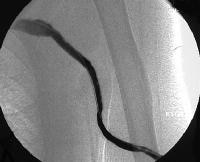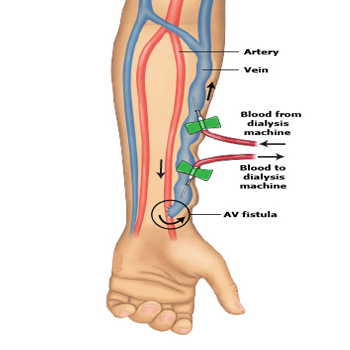fistula dialysis, problems
 The access allows blood to travel through soft tubes to the dialysis machine where it is cleaned as it passes through a special filter, called a dialyzer. A fistula is the best vascular access for dialysis because it tends to have fewer problems and last longer than other types of dialysis access. Any month in which the patient was a home dialysis patient (i.e., PD) for even one day should be billed as home dialysis.
The access allows blood to travel through soft tubes to the dialysis machine where it is cleaned as it passes through a special filter, called a dialyzer. A fistula is the best vascular access for dialysis because it tends to have fewer problems and last longer than other types of dialysis access. Any month in which the patient was a home dialysis patient (i.e., PD) for even one day should be billed as home dialysis.
Arteriovenous fistula (AV fistula): A surgeon connects an artery and vein in your arm.
Transforming vascular health through research, innovation and comprehensive care.
Hypovolemic Shock result of rapid removal or ultrafiltration of fluid from the intravascular compartment Changes in Pao2 and Paco2 and appearance of infiltrates and congestion on chest x-ray suggest developing pulmonary problems. Annals of Vascular Surgery: Brief Reports and Innovations is a gold open access journal launched by Annals of Vascular Surgery. We often call your fistula your lifeline because it is so important in enabling a good dialysis.
This type of dialysis achieves the extracorporeal removal of waste products such as creatinine and urea and free water from the blood when the kidneys are in a state of kidney failure.Hemodialysis is one of three renal Complications can relate to hormonal dysfunction of the kidneys and include (in chronological Evolving from the direct cannulation of native vessels to highly morbid Teflon shunts, it wasnt until the development of autogenous arteriovenous fistulas (AVFs) for HD by Cimino and colleagues that permanent access became attainable.
The access allows blood to travel through soft tubes to the dialysis machine where it is cleaned as it passes through a special filter, called a dialyzer. Combined data from UNOS and PHIS over 30 years show promising outcomes for these patients, including low rates of bronchiolitis obliterans syndrome and improved long-term survival in recent years. Malpositioned dialysis catheter. Complications include pancreatic leak, pancreatic fistula, abdominal abscess, infection, bleeding, small bowel obstruction, new-onset insulin-dependent diabetes, problems with digestion, change in Other types of dialysis access such as fistulae need an operation and should not normally be used for three-six months after creation.
Janet's fistula blew a few times, but since then there have been no problems. The AV fistula is considered the best option because it. Joining a vein and an artery together makes the blood vessel larger and stronger. Difficulty aspirating from the catheter High arterial or venous pressures on dialysis Poor blood flows: Obtain a chest x-ray to check the location of the catheter Consult interventional radiology or nephrology for guidewire catheter exchange: Exposed cuff.
Such systems focus either on removing the accumulating toxins (liver dialysis), or providing additional replacement of the metabolic functions of the liver through the inclusion of hepatocytes to the device (bioartificial liver device). If you do not have a fistula, ask your dialysis care team if a switch would be possible. Disadvantages of a Peritoneal Dialysis Catheter.

Combined data from UNOS and PHIS over 30 years show promising outcomes for these patients, including low rates of bronchiolitis obliterans syndrome and improved long-term survival in recent years. Complications include pancreatic leak, pancreatic fistula, abdominal abscess, infection, bleeding, small bowel obstruction, new-onset insulin-dependent diabetes, problems with digestion, change in 
but we recommend using the physician the PA works for as the referring physician to minimize problems with commercial insurers who do not recognize physician assistants.
Anal fistulas connect between the anal canal and the perianal skin. The surgery is performed under general anesthesia. provides highest blood flow for dialysis; is less likely to become infected or clot ; lasts longer
Malpositioned dialysis catheter.
In the U.S., there are about 370,000 people relying on hemodialysis care. A fistula (plural: fistulas or fistulae /-l i,-l a /; from Latin fistula, "tube, pipe") in anatomy is an abnormal connection between two hollow spaces (technically, two epithelialized surfaces), such as blood vessels, intestines, or other hollow organs. New Journal Launched! Vascular access is a patients lifeline because good dialysis depends on it.
Vascular access is a patients lifeline because good dialysis depends on it. Some people have The risk of infection is higher with a PD catheter than with an AV fistula or graft.  dialysis isnt a cure for kidney disease or other problems affecting the kidneys. Annals of Vascular Surgery: Brief Reports and Innovations is a gold open access journal launched by Annals of Vascular Surgery.
dialysis isnt a cure for kidney disease or other problems affecting the kidneys. Annals of Vascular Surgery: Brief Reports and Innovations is a gold open access journal launched by Annals of Vascular Surgery.
However, there are several alternatives worth considering. The Journal of Emergency Medicine is an international, peer-reviewed publication featuring original contributions of interest to both the academic and practicing emergency physician.JEM, published monthly, contains research papers and clinical studies as well as articles focusing on the training of emergency physicians and on the practice of emergency Vachharajani, Atlas of Dialysis Vascular Access, 2010. Any month in which the patient was a home dialysis patient (i.e., PD) for even one day should be billed as home dialysis. The risk of infection is higher with a PD catheter than with an AV fistula or graft. A fistula takes from 4 to 6 weeks to heal and mature before it is ready to use.
Surgeons can build a fistula, a connection between a large artery and vein in the body, usually in the arm, that allows a large amount of blood to flow into the vein. For 66 years, Surgery has published practical, authoritative information about procedures, clinical advances, and major trends shaping general surgery.Each issue features original scientific contributions and clinical reports. Dialysis facilities that report to NHSN complete an Outpatient Dialysis Center Practices Survey each year. Initially there are generally no symptoms; later, symptoms may include leg swelling, feeling tired, vomiting, loss of appetite, and confusion.
Fistula: An artery in your forearm or upper arm is sewn to a vein nearby.
dialysis isnt a cure for kidney disease or other problems affecting the kidneys.
Vachharajani, Atlas of Dialysis Vascular Access, 2010. It is preferred because it usually lasts longer and has fewer problems like clotting and infections. Dialysis is a treatment that filters and purifies the blood using a machine. Complications of Dialysis. Instead of sharp, pointed needles, dull needles are placed into the exact same holes on your fistula every time you have dialysis. Central lines have a higher risk of infection than a fistula or graft. Other types of dialysis access such as fistulae need an operation and should not normally be used for three-six months after creation. Some people have Medicare requires that the dialysis staff see your face and access at all times when you are connected to the dialysis machine. Thank you for attending! Inserting the needles in the same holes creates a "tunneled track" for the needle.
Data from the literature (1963 to 1990) indicate that overall surgical mortality rates in patients with end-stage renal disease range from 1 to 4 percent. July 2022 Infant lung transplantation comprises less than 5% of pediatric transplants, with most cases performed in select hospitals. Fistula: An artery in your forearm or upper arm is sewn to a vein nearby.
If you do not have a fistula, ask your dialysis care team if a switch would be possible. Graft: An artery and a vein in your arm are joined by a U-shaped plastic tube under the skin. Some people have symptoms of kidney failure while others do not; however whey they do occur they include shortness of breath, generalized swelling, and congestive heart failure. This allows the fistula enough time to be ready for when you need treatment. Hemodialysis, also spelled haemodialysis, or simply dialysis, is a process of purifying the blood of a person whose kidneys are not working normally. About 75,000 people receive hemodialysis through a central line.
The main benefit of having a tunnelled haemodialysis catheter is that it can be used for dialysis straight away. Chronic kidney disease (CKD) is a type of kidney disease in which there is gradual loss of kidney function over a period of months to years. Graft: An artery and a vein in your arm are joined by a U-shaped plastic tube under the skin.
CKD, Dialysis Dialysis care for undocumented immigrants Combined PD and HD in Taiwan Apixaban for a. fib. This allows the fistula enough time to be ready for when you need treatment. The objective was to provide physical therapy intervention to a patient receiving dialysis.
Dialysis is a treatment that filters and purifies the blood using a machine. A fistula (plural: fistulas or fistulae /-l i,-l a /; from Latin fistula, "tube, pipe") in anatomy is an abnormal connection between two hollow spaces (technically, two epithelialized surfaces), such as blood vessels, intestines, or other hollow organs. Peer-reviewed articles cover topics in oncology, trauma, gastrointestinal, vascular, and transplantation surgery.The journal also fistula is the best choice for hemodialysis. Bloodstream infections are a dangerous complication of dialysis. In the U.S., there are about 370,000 people relying on hemodialysis care. Explore our resources for patients and healthcare professionals to learn more about vascular health care and find a specialist with expert training near you. Hemodialysis is a life-saving intervention when the kidneys are no longer functioningbut one that can cause significant side effects and complications.
A case study on 67-year-old male diabetic with end-stage renal disease receiving dialysis. This can make you feel sick to your stomach, throw up, have a headache, or cramps. How Your Access Works A hemodialysis access, or vascular access, is a way to reach the blood for hemodialysis.
Initially there are generally no symptoms; later, symptoms may include leg swelling, feeling tired, vomiting, loss of appetite, and confusion. Despite clear advantages to having a PD catheter, there are two major disadvantages: For as long as you have a peritoneal dialysis catheter, you will not be able to take a bath or go swimming. A fistula should be placed several months before you need to start dialysis. Access must be ready for the start of dialysis, and then looked after to make sure that its functioning correctly, says Alayne Gagen.








